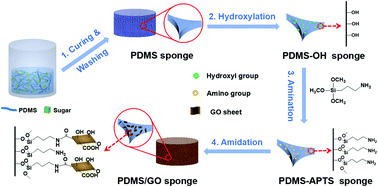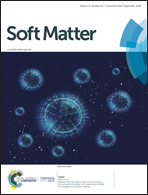Poly(dimethylsiloxane)/graphene oxide composite sponge: a robust and reusable adsorbent for efficient oil/water separation†
Abstract
The development of polymer sponges with large adsorption capacity, high oil/water selectivity and mechanical stability is an effective strategy for the separation of oil from oil-polluted water. The improvement in the adsorption performance for polymer sponges should not be accompanied by the sacrifice of mechanical properties and recycling stability, which are fundamental to their long-term operation in the cleanup of oil-spill accidents. In this work, we synthesized a robust and reusable sponge based on a poly(dimethylsiloxane) (PDMS) frame coated stereoscopically with graphene oxide (GO) via the amidation between PDMS and GO. The combination of the PDMS skeleton with the robust macroporous structure and GO nanosheets acting as mechanical fortifiers contributes to the nanocomposite sponge with great integrity and durability. The resultant PDMS/GO nanocomposite sponge exhibited a high compressive strength of 42.7 kPa with a strain of 60% after 50 cycles. The high adsorption capacity for various oils and organic solvents was obtained in the nanocomposite sponge, and the maximum capacity of 14.6 g g−1 was achieved for chloroform, which is ascribed to the large porosity and hydrophobicity caused by the rough PDMS skeleton covered by the GO nanosheets. Furthermore, a vacuum device with the nanocomposite sponge demonstrated effective separation for a large amount of oil/water mixture, with the maximum separation of 724 times the sponge weight during adsorption. This work provides a productive approach to develop porous polymer nanocomposites with high absorption properties and mechanical cycling stability and paves the path for the application of polymer sponges in oil pollution.



 Please wait while we load your content...
Please wait while we load your content...